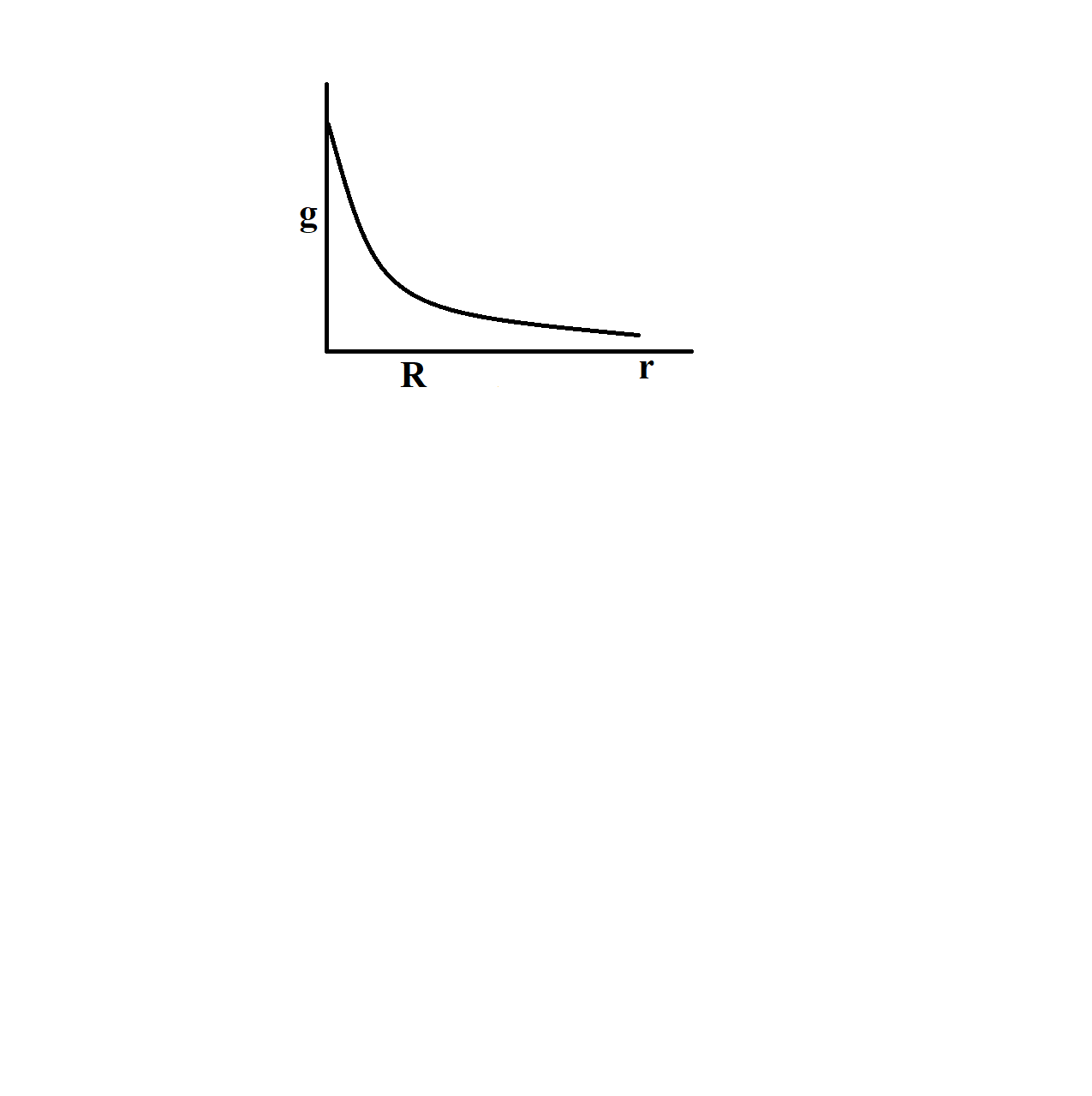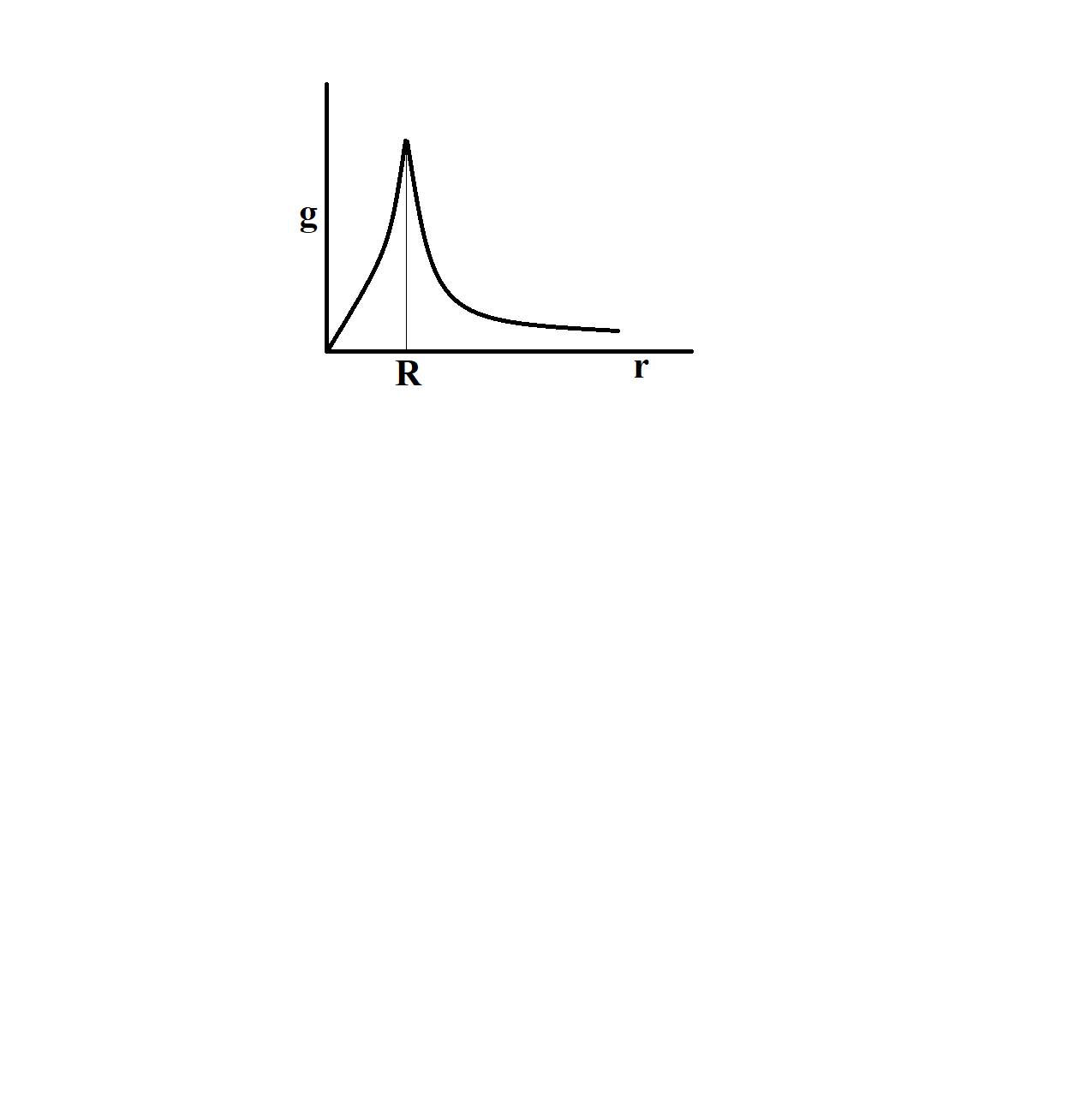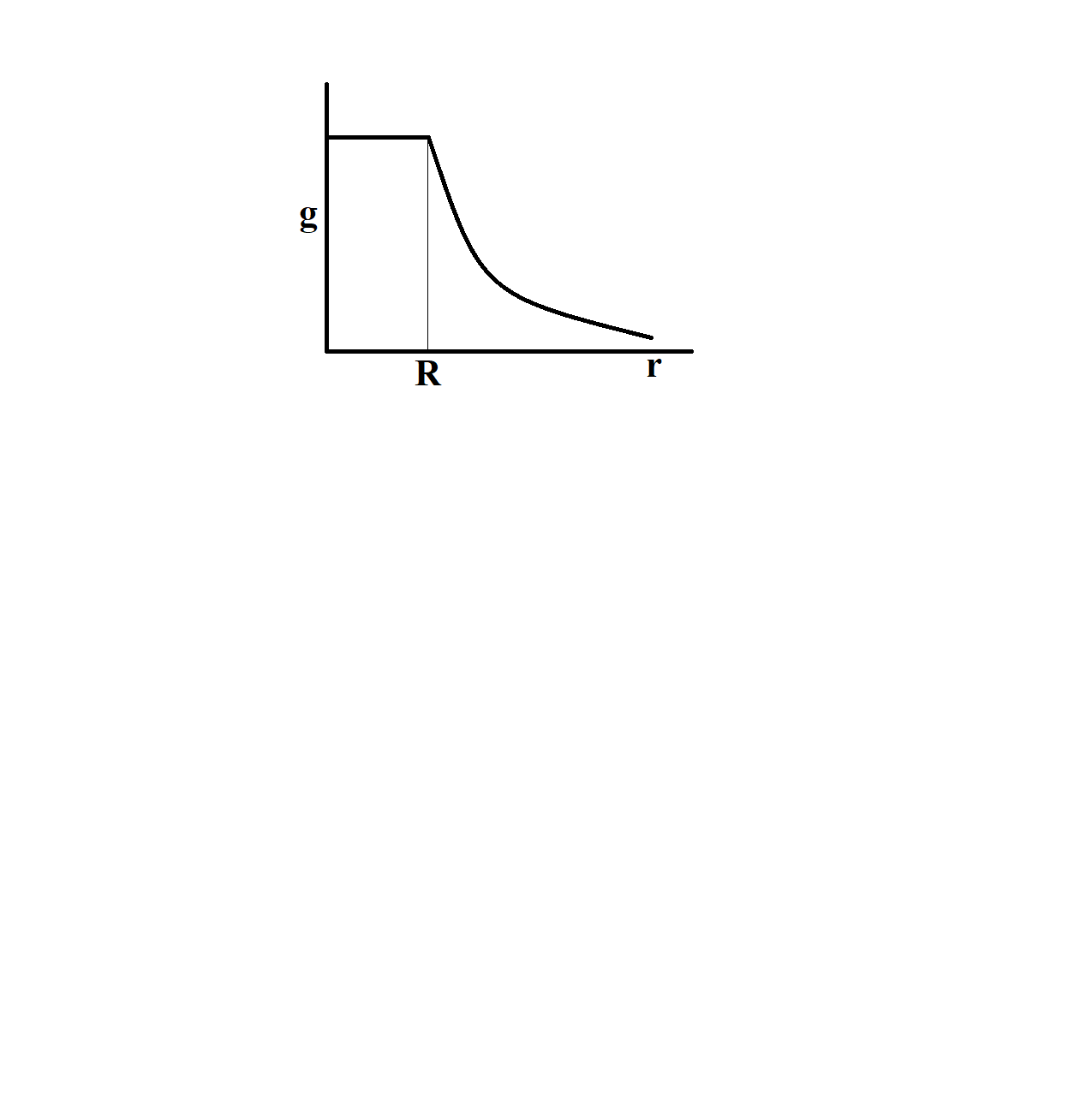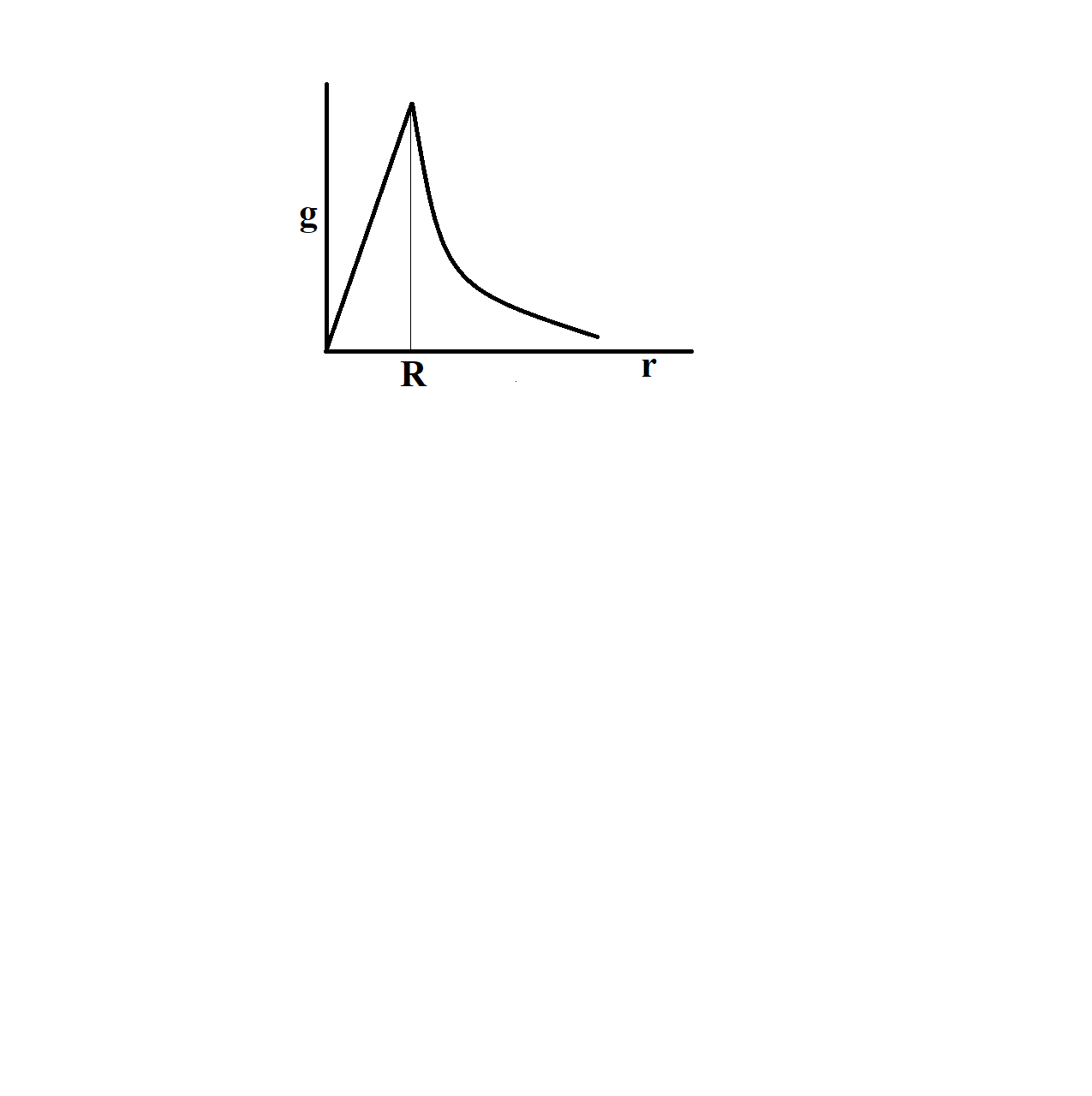Answer
402.9k+ views
Hint: We will consider the variation of value of acceleration due to gravity with the distance from the centre of the earth. Two cases can arise, one for distance from the centre is smaller than the radius of the earth and the other case is distance from the centre is larger than the radius for earth.
Formula used-
For $ R>r $ , $ g'\propto r $
For $ r>R $ , $ g'\propto \dfrac{1}{{{r}^{2}}} $
Complete step-by-step answer:
Gravitational acceleration, or the acceleration due to gravity, is defined as the free fall acceleration of a body in vacuum, without any drag force. The acceleration due to gravity is the acceleration gained by a body because of gravitational force. Its SI unit is $ m{{s}^{-2}} $ . Gravitational acceleration is a vector quantity, meaning it has both magnitude and direction.
The value of gravitational acceleration varies with altitude (height), depth, shape of earth and rotation of earth about its own axis.
The acceleration due to gravity at a depth $ d $ below the surface of earth is given by,
$ \begin{align}
& g'=\dfrac{GM}{{{R}^{2}}}\left( 1-\dfrac{d}{R} \right) \\
& g'=g\left( 1-\dfrac{d}{R} \right) \\
\end{align} $
At the centre of Earth, $ d=R $
$ g'=0 $
At the centre of earth, acceleration due to gravity is zero.
The acceleration due to gravity $ g $ varies with distance $ r $ , where $ r>R $ , is given by,
$ \begin{align}
& g'=\dfrac{g}{{{\left( 1+\dfrac{h}{R} \right)}^{2}}} \\
& g'=\dfrac{g{{R}^{2}}}{{{r}^{2}}} \\
& g'\propto \dfrac{1}{{{r}^{2}}} \\
\end{align} $
Here, $ R+h=r $
For, $ r \[\begin{align}
& g'=g\left( 1-\dfrac{d}{R} \right) \\
& g'=\dfrac{gr}{R} \\
& g'\propto r \\
\end{align}\]
Here, $ R-d=r $
Thus, for $ r>R $ , we have $ g'\propto \dfrac{1}{{{r}^{2}}} $
And for For $ R>r $ , we have $ g'\propto r $
Hence, the correct option is D.
Note:
At a given place, for a fixed value of distance from the centre of earth, the value of acceleration due to gravity is constant. But the value of gravitational acceleration changes from one place to another. For an object placed at some height, the value of gravitational acceleration is less as compared to that placed on the surface of earth. As the depth increases, the value of gravitational acceleration falls.
Formula used-
For $ R>r $ , $ g'\propto r $
For $ r>R $ , $ g'\propto \dfrac{1}{{{r}^{2}}} $
Complete step-by-step answer:
Gravitational acceleration, or the acceleration due to gravity, is defined as the free fall acceleration of a body in vacuum, without any drag force. The acceleration due to gravity is the acceleration gained by a body because of gravitational force. Its SI unit is $ m{{s}^{-2}} $ . Gravitational acceleration is a vector quantity, meaning it has both magnitude and direction.
The value of gravitational acceleration varies with altitude (height), depth, shape of earth and rotation of earth about its own axis.
The acceleration due to gravity at a depth $ d $ below the surface of earth is given by,
$ \begin{align}
& g'=\dfrac{GM}{{{R}^{2}}}\left( 1-\dfrac{d}{R} \right) \\
& g'=g\left( 1-\dfrac{d}{R} \right) \\
\end{align} $
At the centre of Earth, $ d=R $
$ g'=0 $
At the centre of earth, acceleration due to gravity is zero.
The acceleration due to gravity $ g $ varies with distance $ r $ , where $ r>R $ , is given by,
$ \begin{align}
& g'=\dfrac{g}{{{\left( 1+\dfrac{h}{R} \right)}^{2}}} \\
& g'=\dfrac{g{{R}^{2}}}{{{r}^{2}}} \\
& g'\propto \dfrac{1}{{{r}^{2}}} \\
\end{align} $
Here, $ R+h=r $
For, $ r
& g'=g\left( 1-\dfrac{d}{R} \right) \\
& g'=\dfrac{gr}{R} \\
& g'\propto r \\
\end{align}\]
Here, $ R-d=r $
Thus, for $ r>R $ , we have $ g'\propto \dfrac{1}{{{r}^{2}}} $
And for For $ R>r $ , we have $ g'\propto r $
Hence, the correct option is D.
Note:
At a given place, for a fixed value of distance from the centre of earth, the value of acceleration due to gravity is constant. But the value of gravitational acceleration changes from one place to another. For an object placed at some height, the value of gravitational acceleration is less as compared to that placed on the surface of earth. As the depth increases, the value of gravitational acceleration falls.
Recently Updated Pages
Basicity of sulphurous acid and sulphuric acid are

Assertion The resistivity of a semiconductor increases class 13 physics CBSE

Three beakers labelled as A B and C each containing 25 mL of water were taken A small amount of NaOH anhydrous CuSO4 and NaCl were added to the beakers A B and C respectively It was observed that there was an increase in the temperature of the solutions contained in beakers A and B whereas in case of beaker C the temperature of the solution falls Which one of the following statements isarecorrect i In beakers A and B exothermic process has occurred ii In beakers A and B endothermic process has occurred iii In beaker C exothermic process has occurred iv In beaker C endothermic process has occurred

The branch of science which deals with nature and natural class 10 physics CBSE

What is the stopping potential when the metal with class 12 physics JEE_Main

The momentum of a photon is 2 times 10 16gm cmsec Its class 12 physics JEE_Main

Trending doubts
Difference between Prokaryotic cell and Eukaryotic class 11 biology CBSE

Fill the blanks with the suitable prepositions 1 The class 9 english CBSE

Write an application to the principal requesting five class 10 english CBSE

Difference Between Plant Cell and Animal Cell

a Tabulate the differences in the characteristics of class 12 chemistry CBSE

Change the following sentences into negative and interrogative class 10 english CBSE

What organs are located on the left side of your body class 11 biology CBSE

Discuss what these phrases mean to you A a yellow wood class 9 english CBSE

List some examples of Rabi and Kharif crops class 8 biology CBSE







